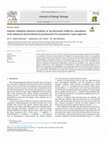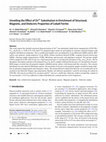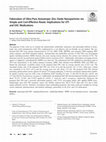Papers by Mohamed Abd El-Kodous

Natural biodegradable polymers have attracted a lot of attention over the past decade because of ... more Natural biodegradable polymers have attracted a lot of attention over the past decade because of their outstanding physical, chemical, mechanical, and physiological properties. Consequently, they are widely employed in many biomedical applications including wound healing, skin regeneration, and bone regeneration as bioscaffolds that mimic the complex 3D environment of cells in vivo. Thus, these natural polymer-based bioscaffolds enhance cell adhesion, proliferation, and differentiation, to replace the dead or damaged parts of the body without inducing inflammation or immune response. In addition, according to their biodegradability, they are promising candidates for short-term implants. This book chapter covers the features of many natural biodegradable polymers and the standards that should be considered upon designing 3D-based bioscaffolds for biomedical applications. Then, various synthetic routes of these polymers with their properties are also summarized, Finally, four common applications (wound healing, skin regeneration, bone regeneration, and implants) are disused in the light of future trends.

Herein, gamma radiation was used to assist the synthesis of Ag decorated nanoplates spinel-type o... more Herein, gamma radiation was used to assist the synthesis of Ag decorated nanoplates spinel-type oxide NiMn 2 O 4 as a prospective electrode for supercapacitors. In addition to accelerating charge transfer, Ag nanoparticles provide a minor extent of pseudocapacitance. When evaluated in an aqueous KOH electrolyte, the Ag@NiMn 2 O 4 electrode displays a capacitance of 622 Fg − 1 at the current density of 1 A g − 1 while retaining exceptional cycle stability (capacitance retention of nearly 88.8 % and 97.6 % coulombic efficiency at 10 Ag − 1 after 5000 cycles). Whereas an asymmetric supercapacitor (Ag@NiMn 2 O 4 //rGO) has been assembled, it has a maximum specific density of 30.44 Wh kg − 1 with a specific power of 10.3006 kW kg − 1 within a broad potential window of 1.6 V. Moreover, the capacitance of the Ag@NiMn 2 O 4 //rGO hybrid supercapacitor device retains roughly retention of 94.8 % and exhibited approximately 100 % coulombic efficiency. As a result, with its enormous capacitance, high specific density, and extended cycle stability, the Ag-decorated the spinel-type oxide NiMn 2 O 4 nanoplates electrode is an auspicious nominee for supercapacitors applications.

Waste Recycling Technologies for Nanomaterials Manufacturing, 2021
“There’s Plenty of Room at the Bottom: An Invitation to Enter a New Field of Physics” said Richar... more “There’s Plenty of Room at the Bottom: An Invitation to Enter a New Field of Physics” said Richard Feynman in 1959, this lecture opened the way to the new field of science which we know today as nanotechnology. Materials’ manipulation at a very small size, ranges from 1 to 100 nm (nanoworld or the nano-edge) is well-known as nanotechnology. Since then, a lot of investigations and research were devoted by many researchers around the globe to keep an eye on the different properties and behavior of nanomaterials. Materials with at least one nanoscale dimension are called nanomaterials that have outstanding features compared to their bulk counterparts. These exceptional characteristics are due to the relatively-high surface area and the relatively-large surface atoms compared to those in the inner mass. Thus, nanomaterials have attractive chemical, physical, electronic, physiological, and optical properties. In this chapter, we are covering the historical overview and origin of nanomaterials to their recent applications. In addition, types and applications of recycled carbon-based nanomaterials as an example have also been discussed.
RSC Advances, 2021
Schematic diagram for the detailed steps of loading CDs-nanocomposite on nickel foam (NF) substra... more Schematic diagram for the detailed steps of loading CDs-nanocomposite on nickel foam (NF) substrate to enhance the electrochemical performance of supercapacitor (SC) electrodes.

Nanotechnology Reviews, 2021
Since the beginning of the third Millennium, specifically during the last 18 years, three outbrea... more Since the beginning of the third Millennium, specifically during the last 18 years, three outbreaks of diseases have been recorded caused by coronaviruses (CoVs). The latest outbreak of these diseases was Coronavirus Disease 2019 (COVID-19), which has been declared by the World Health Organization (WHO) as a pandemic. For this reason, current efforts of the environmental, epidemiology scientists, engineers, and water sector professionals are ongoing to detect CoV in environmental components, especially water, and assess the relative risk of exposure to these systems and any measures needed to protect the public health, workers, and public, in general. This review presents a brief overview of CoV in water, wastewater, and surface water based on a literature search providing different solutions to keep water protected from CoV. Membrane techniques are very attractive solutions for virus elimination in water. In addition, another essential solution is nanotechnology and its application...
Environmental Chemistry Letters, 2021
The rapid urbanization and industrialization is causing worldwide water pollution, calling for ad... more The rapid urbanization and industrialization is causing worldwide water pollution, calling for advanced cleaning methods. For instance, pollutant adsorption on magnetic oxides is efficient and very practical due to the easy separation from solutions by an magnetic field. Here we review the synthesis and performance of magnetic oxides such as iron oxides, spinel ferrites, and perovskite oxides for water remediation. We present structural, optical, and magnetic properties. Magnetic oxides are also promising photocatalysts for the degradation of organic pollutants. Antimicrobial activities and adsorption of heavy metals and radionucleides are also discussed.

International Journal of Biological Macromolecules, 2020
In this research, irradiation by gamma rays was employed as an eco-friendly route for the constru... more In this research, irradiation by gamma rays was employed as an eco-friendly route for the construction of bimetallic silver-gold nanoparticles (Ag-Au NPs), while Gum Arabic polymer was used as a capping agent. Ag-Au NPs were characterized through UV-Vis., XRD, EDX, HR-TEM, FTIR, SEM/mapping and EDX analysis. Antibiofilm and antimicrobial activities were examined against some bacteria and Candida sp. isolates from diabetic foot patients. Our results revealed that the synthesis of Ag-Au NPs depended on the concentrations of tetra-chloroauric acid and silver nitrate. HR-TEM analysis confirmed the spherical nature and an average diameter of 18.58 nm. FTIR results assured many functional groups in Gum Arabic which assisted in increasing the susceptibility of incorporation with Ag-Au NPs. Our results showed that, Ag-Au NPs exhibited the highest antimicrobial performance against B. subtilis (14.30 mm ZOI) followed by E. coli (12.50 mm ZOI) and C. tropicalis (11.90 mm ZOI). In addition, Ag-Au NPs were able to inhibit the biofilm formation by 99.64%, 94.15%, and 90.79% against B. subtilis, E. coli, and C. tropicalis, respectively. Consequently, based on the promising properties, they showed superior antimicrobial potential at low concentration and continued-phase durability, they can be extensively-used in many pharmaceutical and biomedical applications.
Environmental Science and Pollution Research, 2020
In this editorial trend, we aim to collect and present recently available data about the characte... more In this editorial trend, we aim to collect and present recently available data about the characteristics of SARS-CoV-2 virus, severity, infection, replication, diagnosis, and current medications. In addition, we propose the role of nanomaterials in controlling and treating COVID-19 through their antiviral and antibacterial potential with suggested action mechanisms indicating the capability of interaction between these nanomaterials and SARS-CoV-2. These nanomaterials might be among the possible and most effective cures against coronavirus.
Nanotechnology Reviews, 2021
Silver nanoparticles (AgNPs) have been extensively used in various industries; however, this is a... more Silver nanoparticles (AgNPs) have been extensively used in various industries; however, this is accompanied by several implications to humans and the environment. This review focuses on different aspects of AgNPs including the production and detection techniques, their fate, and dynamics in response to different environmental factors. In addition, this review illustrates the toxicity mechanism and the interaction of AgNPs with different matrices, such as aquatic environment, soil, crops, and humans. Reduction measures and future research are discussed.

Environmental Chemistry Letters, 2020
Supercapacitors are increasingly used for energy conversion and storage systems in sustainable na... more Supercapacitors are increasingly used for energy conversion and storage systems in sustainable nanotechnologies. Graphite is a conventional electrode utilized in Li-ion-based batteries, yet its specific capacitance of 372 mA h g−1 is not adequate for supercapacitor applications. Interest in supercapacitors is due to their high-energy capacity, storage for a shorter period and longer lifetime. This review compares the following materials used to fabricate supercapacitors: spinel ferrites, e.g., MFe2O4, MMoO4 and MCo2O4 where M denotes a transition metal ion; perovskite oxides; transition metals sulfides; carbon materials; and conducting polymers. The application window of perovskite can be controlled by cations in sublattice sites. Cations increase the specific capacitance because cations possess large orbital valence electrons which grow the oxygen vacancies. Electrodes made of transition metal sulfides, e.g., ZnCo2S4, display a high specific capacitance of 1269 F g−1, which is four...

Journal of Hazardous Materials, 2021
The problem of hazardous wastewater remediation is a complicated issue and a global challenge. He... more The problem of hazardous wastewater remediation is a complicated issue and a global challenge. Herein, a layered Co0.5Ni0.5Fe2O4/SiO2/TiO2 composite matrix was prepared and incorporated with three carbon nanomaterials having different dimensionalities, carbon dots (C-dots, 0D), single-walled carbon nanotubes (1D), and reduced graphene oxide (2D), in an effort to create effective photocatalytic nanocomposites for chloramine-T removal from water. Microstructural analyses confirmed the formation of nanocomposites and revealed their chemistry and structure. Elemental mapping revealed a uniform distribution of elements throughout the nanocomposite matrix that was free of impurities. The spherical shape of the matrix particles (average diameter ~90 nm) and their conjugation with the carbon nanomaterials were confirmed. Nitrogen adsorption-desorption isotherms revealed that the nanocomposites were mesoporous but also contained macropores. The surface chemical compositions of the nanocomposites were investigated and showed a range of available binding energies. The kinetics of photocatalysis by the system were studied, and the effects of different parameters (such as photocatalyst dose and charge-carrier scavengers) on the efficiency of chloramine-T degradation were also investigated. The nanocomposite loaded with 10% C-dots exhibited high UV-assisted photocatalytic activity for chloramine-T degradation (65% removal efficiency).

Applied Microbiology and Biotechnology, 2020
Neurodegenerative disorders especially Alzheimer's disease (AD) are significantly threatening the... more Neurodegenerative disorders especially Alzheimer's disease (AD) are significantly threatening the public health. Acetylcholinesterase (AChE) inhibitors are compounds of great interest which can be used as effective agents for the symptomatic treatment of AD. Although plants are considered the largest source for these types of inhibitors, the microbial production of AChE inhibitors represents an efficient, easily manipulated, eco-friendly, cost-effective, and alternative approach. This review highlights the recent advances on the microbial production of AChE inhibitors and summarizes all the previously reported successful studies on isolation, screening, extraction, and detecting methodologies of AChE inhibitors from the microbial fermentation, from the earliest trials to the most promising anti-AD drug, huperzine A (HupA). In addition, improvement strategies for maximizing the industrial production of AChE inhibitors by microbes will be discussed. Finally, the promising applications of nano-material-based drug delivery systems for natural AChE inhibitor (HupA) will also be summarized. Key Points • AChE inhibitors are potential therapies for Alzheimer's disease. • Microorganisms as alternate sources for prospective production of such inhibitors. • Research advances on extraction, detection, and strategies for production improvement. • Nanotechnology-based approaches for an effective drug delivery for Alzheimer's disease.

Journal of Materials Science: Materials in Electronics, 2020
Substitutions of cations were considered to be the main way for improving the performance of ferr... more Substitutions of cations were considered to be the main way for improving the performance of ferrite nanocrystalline structures. In this paper, non-magnetic and magnetic ions were conducted to substitute cobalt spinel ferrite nanoparticles CoFe2O4 NPs (CFO NPs). The studied Co1−xMxFe2O4; M = Zn, Cu, and Mn; x = 0.00, and 0.50) samples were synthesized through a cost-effective sol–gel technique. The outstanding properties of the samples are addressed using XRD, FTIR, the inductively coupled plasma optical emission spectrometer (ICP-OES), Raman analyses, HR-TEM, BET surface area analyzer, the energy-dispersive X-ray analysis spectra (EDX), and vibrating sample magnetometer (VSM). The Rietveld analysis and FTIR spectroscopic measurements revealed the successful synthesis of the cubic spinel phase. HR-TEM images reveal that the particles of all samples had spherical shape in the nanometer range. Moreover, the synthesized ZCFO NPs has the highest specific surface area of 26.87 m2/g than other samples. Interestingly, the determined Debye temperature from both elastic and infrared data was in a good conformity with each other. Finally, the values of saturation magnetization (Ms) increased from 39.128 emu/g for CCFO NPs to 68.419 emu/g for CFO NPs. The observed coercive field increased from 213.93 G for ZCFO NPs sample to 1914.85 G for CCFO NPs.

Journal of Cluster Science, 2020
In the present work, a single crystal of alanine and hippuric acid was prepared through the slow ... more In the present work, a single crystal of alanine and hippuric acid was prepared through the slow growth dynamics of sample evaporation. The crystallinity, structure, and cell parameters of the produced single crystals were determined by X-ray diffraction (XRD) analysis. While, frequency shifting and the various functional groups of alanine with hippuric acid were investigated by FTIR and FT-Raman studies. In addition, grain size and the morphological shape of alanine hippurate (AH) single crystals were examined by FE-SEM analysis. Transmission of light through the grown material was defined by UV-VIR-NIR study. Moreover, mechanical stability of the grown single crystals was analyzed with Vicker’s microhardness tester. Melting point and thermal stability were tested through TGA, DGA, and DSC investigations. Our results explored that, the prepared single crystals exhibited high-grade transparency and lower cut-off wavelength of about 300 nm. UV–VIS–NIR absorption spectrum revealed that there was less absorption in the visible region, and an emission peak at 574 nm was observed confirming the green emission of the prepared crystals. Interestingly, microhardness investigation showed that our single crystals belonged to the category of soft materials. While, thermal studies investigated the prepared crystals were stable up to 290 °C. Finally, the recorded SHG performance was 1.26 times that of KDP.
International Journal of Hydrogen Energy, 2022
Al doped SrTiO 3 perovskite photocatalyst was prepared by a molten flux method. AleSrTiO 3 was lo... more Al doped SrTiO 3 perovskite photocatalyst was prepared by a molten flux method. AleSrTiO 3 was loaded with plasmonic NPs, RhCr 2 O 3 , CoOOH cocatalysts for HE and OE. Cocatalyst distribution on active sites of the main photocatalyst was controlled. Water splitting and H 2 production was evaluated under UV, UVeVis, and visible light. Visible light active system was developed for H 2 evolution with no sacrificial agents.

Journal of Inorganic and Organometallic Polymers and Materials, 2020
This work reports the detailed structural characterization of Zn 2+ ion-substituted cobalt ferrit... more This work reports the detailed structural characterization of Zn 2+ ion-substituted cobalt ferrite nanoparticles (CFO NPs; Co 1−x Zn x Fe 2 O 4 ; x = 0.00, 0.25, 0.50, and 0.75), prepared using a facile sol-gel method. It correlates structural changes with magnetic and dielectric properties. The as-synthesized samples were investigated by X-ray diffraction (XRD) analysis, BET surface area analyzer, energy-dispersive X-ray (EDX), Fourier transform infrared (FTIR), scanning electron microscopy (SEM), vibrating sample magnetometer (VSM), Mössbauer spectroscopy, and impedance analyzer. The pristine sample (CFO) comprised of NPs with 25 nm size, which decreased up to 11 nm upon the formation of Zn 0.75 Co 0.25 Fe 2 O 4. The N 2 adsorption-desorption isotherm of the prepared Zn 0.5 Co 0.5 Fe 2 O 4 sample confirmed the presence of a mesoporous structure. SEM images revealed that all prepared samples exhibited porous surface with honeycomb-like structures. The cationic distribution was described by Mössbauer spectra. The increment of Zn ions in the prepared samples resulted in sharp reduction of saturation magnetization and remanence values. The normal dielectric dispersion behavior was recorded and can be ascribed to the Maxwell-Wagner type polarization. Besides, the dielectric parameters varied by increasing Zn content in CFO NPs. This may be ascribed to O 2 vacancies and Fe 3+ ions in A-and B-sites. Dielectric studies revealed that, content of Zn ions beyond x = 0.25 was sufficient to reduce both dielectric constant and loss at low frequencies.
RSC Advances, 2020
In this paper, we report a layer-by-layer approach for the preparation of a concentric recyclable... more In this paper, we report a layer-by-layer approach for the preparation of a concentric recyclable composite (CoxNi1−xFe2O4/SiO2/TiO2;x= 0.9) designed for wastewater treatment.
Organic Electronics, 2019
This is a PDF file of an article that has undergone enhancements after acceptance, such as the ad... more This is a PDF file of an article that has undergone enhancements after acceptance, such as the addition of a cover page and metadata, and formatting for readability, but it is not yet the definitive version of record. This version will undergo additional copyediting, typesetting and review before it is published in its final form, but we are providing this version to give early visibility of the article. Please note that, during the production process, errors may be discovered which could affect the content, and all legal disclaimers that apply to the journal pertain.

Biological Trace Element Research, 2019
The purposes of this work are to evaluate the antimicrobial, antibiofilm, anticancer, and antioxi... more The purposes of this work are to evaluate the antimicrobial, antibiofilm, anticancer, and antioxidant abilities of anisotropic zinc oxide nanoparticles (ZnO NPs) synthesized by a cost-effective and eco-friendly sol-gel method. The synthesized ZnO NPs were entirely characterized by UV-Vis, XRD, FTIR, HRTEM, zeta potential, SEM mapping, BET surface analyzer, and EDX elemental analysis. Antimicrobial and antibiofilm activities of ZnO NPs were investigated against multidrug-resistant (MDR) bacteria and yeast causing serious diseases like urinary tract infection (UTI). The anticancer activity was performed against Ehrlich ascites carcinoma (EAC). Additionally, antioxidant scavenging activity against 2,2-diphenyl-1-picrylhydrazyl (DPPH) was observed. The synthesized ZnO NPs exhibited an absorption peak at 385.0 nm characteristic to the surface plasmon resonance (SPR). Data obtained from HRTEM, SEM, and XRD confirmed the anisotropic crystalline nature of the prepared ZnO NPs with an average particle size of 68.2 nm. The calculated surface area of the prepared ZnO NPs was 10.62 m 2 /g and the porosity was 13.16%, while pore volume was calculated to be 0.013 cm 3 /g and the average pore size was about 3.10 nm. The prepared ZnO NPs showed promising antimicrobial activity against all tested UTI-causing pathogens. It showed a prominent antimicrobial capability against Candida tropicalis with a zone of inhibition (ZOI) reaching 22.4 mm, 13 mm ZOI for Bacillus subtilis, and 12.5 mm ZOI for Pseudomonas aeruginosa. Additionally, the prepared ZnO NPs showed enhanced biofilm repression of about 79.33%, 72.94%, and 33.68% against B. subtilis, C. tropicalis, and P. aeruginosa, respectively. Moreover, the prepared ZnO NPs had a powerful antioxidant property with 33.0% scavenging ability after applied DPPH assay. Surprisingly, upon ZnO NPs treatment, cancer cell viability reduced from 100 to 58.5% after only 24 h due to their unique antitumor activity. Therefore, according to these outstanding properties, this study could give insights for solving serious industrial, pharmaceutical, and medical challenges, particularly in the EAC and UTI medications.






Uploads
Papers by Mohamed Abd El-Kodous